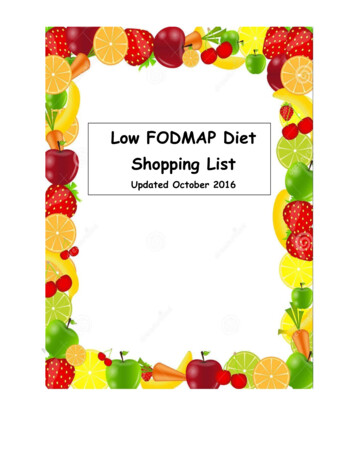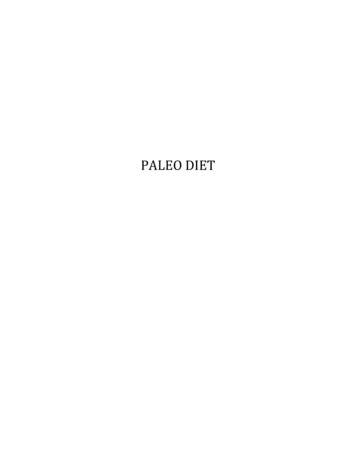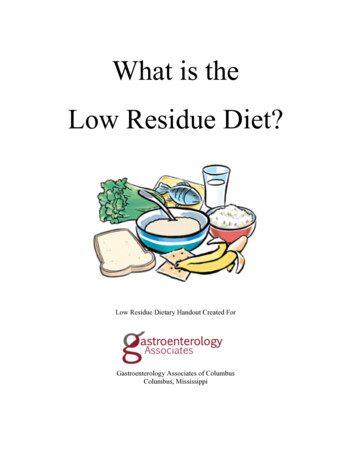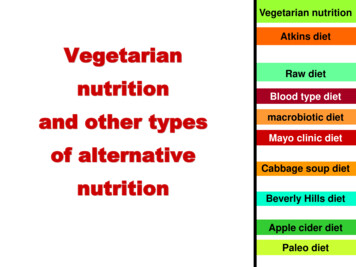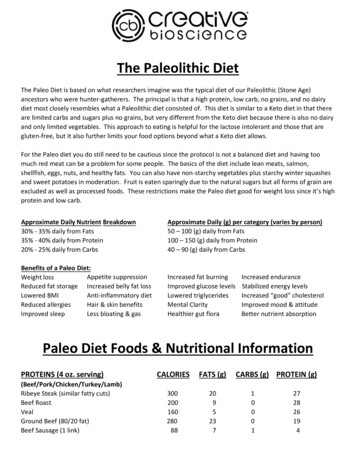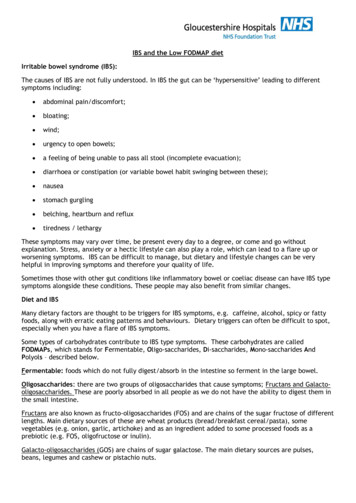
Transcription
IBS and the Low FODMAP dietIrritable bowel syndrome (IBS):The causes of IBS are not fully understood. In IBS the gut can be ‘hypersensitive’ leading to differentsymptoms including: abdominal pain/discomfort; bloating; wind; urgency to open bowels; a feeling of being unable to pass all stool (incomplete evacuation); diarrhoea or constipation (or variable bowel habit swinging between these); nausea stomach gurgling belching, heartburn and reflux tiredness / lethargyThese symptoms may vary over time, be present every day to a degree, or come and go withoutexplanation. Stress, anxiety or a hectic lifestyle can also play a role, which can lead to a flare up orworsening symptoms. IBS can be difficult to manage, but dietary and lifestyle changes can be veryhelpful in improving symptoms and therefore your quality of life.Sometimes those with other gut conditions like inflammatory bowel or coeliac disease can have IBS typesymptoms alongside these conditions. These people may also benefit from similar changes.Diet and IBSMany dietary factors are thought to be triggers for IBS symptoms, e.g. caffeine, alcohol, spicy or fattyfoods, along with erratic eating patterns and behaviours. Dietary triggers can often be difficult to spot,especially when you have a flare of IBS symptoms.Some types of carbohydrates contribute to IBS type symptoms. These carbohydrates are calledFODMAPs, which stands for Fermentable, Oligo-saccharides, Di-saccharides, Mono-saccharides AndPolyols – described below.Fermentable: foods which do not fully digest/absorb in the intestine so ferment in the large bowel.Oligosaccharides: there are two groups of oligosaccharides that cause symptoms; Fructans and Galactooligosaccharides. These are poorly absorbed in all people as we do not have the ability to digest them inthe small intestine.Fructans are also known as fructo-oligosaccharides (FOS) and are chains of the sugar fructose of differentlengths. Main dietary sources of these are wheat products (bread/breakfast cereal/pasta), somevegetables (e.g. onion, garlic, artichoke) and as an ingredient added to some processed foods as aprebiotic (e.g. FOS, oligofructose or inulin).Galacto-oligosaccharides (GOS) are chains of sugar galactose. The main dietary sources are pulses,beans, legumes and cashew or pistachio nuts.
Disaccharides: Lactose is a sugar found in all animal milks. Milk and yogurt are main sources of lactoseMonosaccharides: Fructose is a simple sugar but in excessive amounts may be poorly absorbed by some.AndPolyols: Polyols are sugar alcohols such as sorbitol, mannitol and xylitol. These are poorly absorbed inmost people. These occur naturally in some fruits and vegetables, but are also used as artificialsweeteners in sugar free chewing gum, mints, and other low calorie or sugar free products.Even though some FODMAPs are poorly absorbed in everyone, they only need to be restricted if theycause symptoms. People with IBS-like symptoms appear to be sensitive to the gases produced and waterchanges in the large intestine that occur when the diet contains lots of FODMAPs. Reducing the intake ofFODMAP’s has been shown to improve gut symptoms in most individuals with IBS-like symptoms.Following the diet: How strict do I need to be?Try to follow the low FODMAP diet as closely as possible to give you the best chance to improve yoursymptoms. Usually 4-6 weeks is long enough to identify if symptoms will respond to a low FODMAP diet.After the initial 4-6 weeks it is important that you reintroduce the avoided foods to identify whichparticular groups of carbohydrate cause you symptoms. Sensitivity to FODMAPs varies between people,and reintroduction to FODMAP containing foods is often well tolerated. Although a low FODMAP diet canbe nutritionally balanced, working out what you are most sensitive to helps to increase food choices inyour diet.The tables below provide an overview of the foods needing to be avoided and those that can be eatenwhilst following a low FODMAP diet. It is not an exhaustive list. Further details on other foods and safequantities can be found on the Monash University or low FOMDAP food maestro odmaestro.me/consumer-apps (scroll down to bottom half of the webpage)The foods listed below do not contain any FODMAPs and may be eaten freely:Meat, poultry, fish, eggs or vegetarian protein foods. Eat 1-2 portions per day. One portion is 75-100gor 2 eggs. Fresh and frozen without sauce or coating: beef, chicken, duck, lamb, pork (including bacon andham), turkey.Fresh or frozen shellfish, white fish, oily fish.Tinned fish in brine or oil.Eggs (boiled, fried, poached, scrambled).Firm tofu, tempeh.Quorn (Check ingredients: some varieties contain onion and/or garlic)Textured vegetable protein (soya mince)Fats, oils & spreadsFor a healthy diet try eating less foods containing fat. Fats are high in calories so use sparingly, and cancontribute to IBS symptoms in some people. Chose polyunsaturated or monounsaturated where possible. Cooking oils, margarines, low fat spreads, butter, ghee, lard, suet.
Starchy FoodsMinor wheat ingredients in a food do not need to be avoided (e.g. thickeners and flavourings).Foods to avoidSuitable foods(high in fructans, GOS or polyols):But check ingredients label for problem fruit, FOS,inulin, oligofructose.Cereal Grains- Wheat (including bulghur wheat, couscous,semolina)- Rye,- Barley- AmaranthBreadAll wheat bread and rolls: white, wholemeal, multigrain ,sourdough (small amounts may be ok) Pitta bread, bagels, ciabatta, focaccia,Panini, naan bread, chapatti Croissants, muffins, brioche, pastriescrumpets and most bakery goods Garlic bread, pizza bases Rye bread, spelt bread.Cereal grains and starchy foodsRice (and rice bran), oats (and oat bran),tapioca, potatoes, buckwheat, polenta, corn,quinoaBread Wheat free / Gluten free bread and rollsBread made from: oat, rice, corn,tapioca, potato flours100% spelt sourdough (only)Wheat free or gluten free pizza bases,pitta bread, ciabatta, naan bread.Homemade wheat free bread using abreadmaker is a good optionFlour All wheat flour white, wholemeal, plain, strong, selfraising Rye, barley, gram (Chick Pea) flours coconut flour, spelt flour, soya flourFlour and raising agentsPasta and noodles All fresh and dried pasta (white andwholemeal), Gnocchi, spelt pasta, chickpea /lentil pastaPasta and noodles Egg noodles, Hokkein, Udon, Potnoodles, Supernoodles, Ramen Wheat free / gluten free flour,buckwheat, cornflour, millet flour,maize flour, polenta, potato, rice flour.Baking powder, bicarbonate of soda,cream of tartar, yeast. arrowroot,Wheat free / gluten free pasta (notmade from lentils/chickpeas),buckwheat, quinoa pastaRice noodles, buckwheat noodles, kelpnoodlesBreakfast cereals Wheat or bran based cereals (weetabix,shredded wheat, bran flakes, All-bran,cheerio’s, muesli), wheat bran, wheat germ, spelt flakesBreakfast CerealsSavoury BiscuitsSavoury Biscuits / snacksWater biscuits, crisp breads, Cornish wafers,cream crackers, spelt crackersRice crackers, corncakes, oatcakes, wheat freeor gluten free crackers.Rye crispbreadsPlain / salted popcorn or plain crisps Porridge / oat cereals, oat brancornflakes, rice krispies,some wheat free or gluten free muesliand cereals (check fruit).
Sweet BiscuitsSweet biscuitsAll biscuits made with wheat flour (digestives,shortbread, rich tea, custard creams etc)Some Florentines, macaroons, oat basedbiscuits, flapjacks.CakesMost ‘free from’ biscuit varietiesCakesAll cakes made with wheat flour (fruit cake,fairy cake, Victoria sponge, chocolate cake etc)PastryAll pastry made with wheat flour (shortcrust,puff, flaky, filo,)Shop brought pastry and pastry goods (pies,quiche, pasties)Breadcrumbs and batterCrumbed fish and poultry, fish fingers, fish inbatter, tempura batter, scotch eggs.Flourless cakes, meringues, cornflour sponge.Most ‘free from’ varieties are wheat free.PastryWheat free or gluten free varieties and mixes.BreadcrumbsPolenta, oats, cornflake crumbs, gluten freebreadcrumbs/ batter
Fruit and VegetablesFoods to avoidSuitableFruit (Fresh, dried or juice)FruitApple, Apricot, Blackberry, Cherries, Dates,Figs, Mango, Nectarine, Peach, Pear,Plum/prune, Sultanas, Watermelon,Aim for 3 portions, but spread through the day. Oneportion at a time 80g fresh fruit, 1tbs dried fruitor100ml fruit juice. Portion sizes in brackets are forfruits which must be more strictly limited*.Tinned fruit in apple or pear juice.Tropical fruit juice, or juices from fruits aboveJams, sauces or chutneys containing fruitsabove.Banana, Blueberry , Cantaloupe , Clementine,Cranberries, Galia melon, Grapes, Grapefruit*( half, small), Honeydew melon, Kiwi, Lemon,Lime , Lychee* ( 5) Mandarin, Orange, Passionfruit, Papaya, Pineapple, Pomegranate*(halfsmall) Raspberry, Raisins Rhubarb, StrawberryVegetablesVegetablesVegetables with * may be eaten in very smallquantities ( 3tbs /day). Those underlined must bestrictly avoided.Try to have at least 2 portions per day. One portionArtichoke hearts*, Artichoke (Jerusalem),Asparagus*, Avocado* ( ¼ ). Beetroot*,Broccoli*, Brussels Sprouts*, Butternut squash*,Cauliflower, Celery*, Chicory root, Fennel*(bulb and leaves) Garlic, Leek, Mange tout*,Mushroom, Okra*, Onion (red, white, Spanish,shallots), Peas*, Savoy Cabbage*, Spring onion(white part). Sweet potato*, Sweetcorn*,Alfalfa, Asparagus, Sugar snap peas, Aubergine,Bamboo shoot, Beansprouts, Carrot, Chard,Chilli, Chive, Courgette, Cucumber, Endive,Green beans, Lettuce, Olive, Pak Choy, Parsnip,Pepper (green, orange, yellow and red),Plantain, White Potato, Pumpkin, Radish,Rocket, Seaweed, Spinach, Spring onion (greenpart only), Swede, Tomato, Turnip, White orred cabbageBeans and pulses (chickpeas, broad beans, soybeans, black eyes beans, butter beans, lentils,baked beans, kidney beans, split peas).is 80g (2-3tbs). There is no upper limit to theamount you can have at onceFlavoured crisps. soups, stocks, gravy, sauces,dressings, & ready mealsSoups, stocks, gravy, sauces, dressings &ready mealsThese should be avoided as they routinelycontain garlic or onion ingredientsUse homemade alternatives with dried herbsand spices or chives below. Garlic infused oil(strained) may be used and Asofoetida powder(hing) can provide onion flavour.Garlic or onion ingredients: These should beavoided as they are a concentrated source ofFODMAPs. Check ingredients labels.Dried onion or garlic, garlic or onion extract,garlic or onion powder, garlic or onion puree,garlic or onion salt.Salt, pepper, white/rice vinegar, balsamicvinegar (1tbs only) any herbs, spices, chilli,chives, cinnamon, coriander, ginger,lemon/lime juice green part of spring onion,marmite, mustard,
Foods to avoidSuitableSugars, preserves, sauces and confectionarySugars, preserves and confectionaryHoney, Agave nectar, Fructose syrup,Sugar, golden syrup, maple syrup, treacle, jamand marmalade (from suitable fruits).Sweet and savoury sauces, snack bars.Check ingredients label for: glucose-fructosesyrup, fructose-glucose syrup, high fructosecorn syrup and high fructose corn syrup solids.Added PolyolsSugar-free mints, Sugar-free chewing gums,sugar-free lollies, sugar-free chocolate, some‘diet/low calorie’ products, protein powdersand supplement drinks.Check ingredients in low sugar or reduced sugarjam and marmalade for Polyols.Some artificial sweeteners: aspartame,acesulfame K, saccharin, Canderel, Silver spoonSplenda, Hermesetas.Most people in the UK eat too much sugar. For ahealthy diet you should try eating less foodcontaining added sugars. High sugar foods containmore than 15g per 100g and low sugar foods containup to 5g sugars per 100g.Check ingredients label for sorbitol, mannitol,xylitol, isomalt.Added FructansFoods or tablets with added fibre or prebioticse.g some yoghurts, fermented milk drinks,snack bars, breakfast cereals.Check ingredients labels for FOS, inulin,oligfructose.Nuts and seedsNuts and seedsCashew and Pistachio Nuts.Most are suitable in moderation (small handful)Coconut (dried) in large quantities.Macadamia nuts, peanuts, pecans, pine nuts,pumpkin seeds, sesame seeds, sunflower seeds,walnuts.Coconut, dried ( 3 tbs)Almonds and hazelnuts - maximum 10.Peanut butterDrinksDrinksChicory (Camp), Dandelion tea, Camomile,Chai, Fennel.Have at least 6-8 glasses or 1.5-2.0 litres offluid per day. Choose water or non-caffeinateddrinks and limit fizzy drinks.Check fruit and herbal teas for unsuitable fruit(apple).Alcohol-Rum, Dessert wine.Alcohol – is a stimulant and may increase IBSsymptoms. While most alcoholic drinks are lowin FODMAP’s, if alcohol increases yoursymptoms, limit your intake.
High Lactose Foods - avoidMilkWhole, skimmed, semi-skimmed milk,goats, sheeps milk, buttermilk*milk powder, evaporated milk,condensed milk.YoghurtWhole milk, low fat, greek, drinkingyoghurts*.Fromage frais.Suitable lactose alternativesMilk Ensure alternative milks are calcium enriched. Checkalternative milks for apple juice, fructose and inulin. Lactose free milk (Lactofree, own brands)Almond or hazelnut milk 60ml Soya milk 200ml Rice milk (Rice Dream, Alpro) 50ml Oat Milk (Oatly Oat Drink)*¼ cup (50ml) maximum of whole, skimmed orsemi –skimmed milk is permitted in a drink, partof a meal or snackYoghurt Check for problem fruit, FOS, inulin, oligofructose.fruit juice concentrate, fructose. Lactose free cow’s milk yoghurtMax 125g Soya yoghurtCoconut yoghurt*2tbs maximum (check for other FODMAP’s) ispermitted as part of a meal or snack.Cheese*CheeseProcessed cheese, cheese slices,reduced fat cheddar*2 tbs maximum Cottage cheese, ricotta, quark, low fatsoft cheese, mascarpone, 2 slices halloumi.Cheddar, feta, mozzarella, brie, camembert, blue,cream cheese, Edam, goats.Other dairy:Other dairy:Custard*Butter, cream, sour cream, crème fraiche are lowlactose in small amounts.CustardStandard custard made fromcows/goats milkIce cream*Dairy ice cream, goats milk ice creamChocolate*Soya custard /Custard desserts (Alpro – all flavours)*2 tbs maximum of normal custard is allowed. If makingfrom powder use lactose-free milk.Ice cream check for other FODMAP’s Lactose free ice-cream (Lactofree)Soya ice cream (Swedish Glace)*1 scoop maximum of normal ice cream.Chocolate: Dark chocolate Ok*30g maximum of milk / white chocolate.*These foods are tolerated in small amounts – see suitable food column for amounts.
Low FODMAP Meal Plan: Choose from the following meal ideas:Breakfast Porridge or wheat free cereal with suitable milkWheat/rye- free toast with cheese/suitable jam/peanut butter2 eggs on wheat/rye free or 100% sourdough spelt toastCheese and chive omeletteSmoothie made with suitable fruit and lactose-free yogurtCooked breakfast – bacon, egg, tomato, hash brown with wheat/rye free or sourdough spelt toastLunch Wheat/rye free sandwich/pitta/wrap or wheat/rye free crispbread withtuna/sardines/salmon/egg/cheese/cold meat/poultry/ham with saladHomemade soup made with suitable vegetables and wheat free bread.Baked potato or rice with tuna/ cheese or homemade filling (e.g. chilli)Salad/rice salad/potato salad/gluten free pasta salad with cold meat/tuna/eggs/cheeseSushi/sashimiSuitable fruit/yoghurtDinner Steak /chop/fish/poultry /tofu/Quorn with suitable vegetables and rice/rice noodles/wheat freepasta/gluten free pasta/potato /polentaRisotto or omelette with saladGluten free pasta/spaghetti with bolognaise (no onion/garlic) with saladCorn taco shells with beef mince, crème fraiche and saladSuitable fruit/fruit salad/ rice pudding/ice cream/yoghurt/custard.Beverages Water /- lemonSemi-skimmed milk (or alternative milk)Tea/coffee1/3 glass (100ml) fruit juice/smoothie made with suitable fruit. Tip: add water to fruit juice tomake a longer drink.Fruit squash – suitable fruit flavours (check sweeteners)Snacks Suitable fruitLow fat yoghurt (check ingredients lactose free if needed)Vegetable sticks and dip (check for onion)Cheese and tomato/ peanut butter on rice crackers/corn/oat cakesHandful of suitable nutsOccasionally: Potato crisps (unsalted, ready salted or salt and vinegar), popcorn, dark chocolate,wheat free / gluten free cakes.
Eating out on a low FODMAP dietEating out can be challenging on a low FODMAP diet. You need to choose carefully, but some restaurantsand food outlets now provide wheat and gluten free options for those that need it, which can be a usefulstarting point.Suitable choices for main meal: Fish, poultry or meat with potatoes, salad or vegetables (e.g. steak/fish and chips) Risotto (request no onion/leek) with suitable vegetables Baked potato with salad and suitable filling. Asian style rice or rice noodle dishes (check vegetables), sushi. Gluten free pizza (choose your own toppings)Tips Avoid eating coatings, batter, sauces, Choose options that are without a sauce (e.g. steak, stir fry, risotto) Ask for sauce or gravy to beserved in a separate dish Gluten free options avoid wheat but check for other ingredients e.g. leek in gluten free pie.Enjoy eating out! Some people get symptoms when eating out because it is difficult to avoid allproblem ingredients. However, eating out is a social experience and benefits should outweigh thesymptoms.What if my symptoms do not improve on a low FODMAP diet?The low FODMAP diet is beneficial for many individuals with IBS-like symptoms but not for everyone. Ifyou have followed the closely but your symptoms have not improved after 6 weeks please contact yourdoctor/dietitian for further advice.What about foods not listed?Further details on other foods and safe quantities can be found on the Monash University or low FODMAPfood maestro odmaestro.me/consumer-apps (scroll down to bottom half of the webpage)For further support, ideas for meals, recipes and information, please view our support page.
Sugar-free mints, Sugar-free chewing gums, sugar-free lollies, sugar-free chocolate, some 'diet/low calorie' products, protein powders and supplement drinks. Check ingredients label for sorbitol, mannitol, xylitol, isomalt. Added Fructans Foods or tablets with added fibre or prebiotics e.g some yoghurts, fermented milk drinks,
